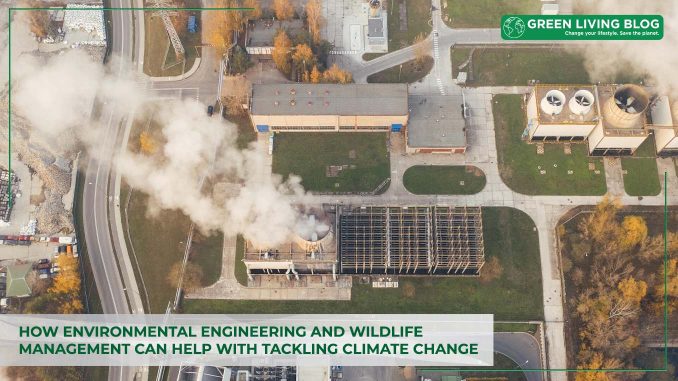
Amidst the growing urgency of climate change, it has become imperative to address environmental challenges head-on.
The fields of Environmental Engineering and Wildlife Management emerge as crucial allies in this battle. As our planet faces unprecedented shifts, from rising temperatures to ecosystem disruptions, these disciplines offer invaluable strategies to mitigate the impacts of climate change.
The United Nations warns that “To limit global warming to 1.5°C above pre-industrial levels, emissions must already be decreasing and need to be cut by almost half by 2030, just seven years away.”
By devising sustainable infrastructure solutions, promoting eco-friendly products and practices, and safeguarding biodiversity, we pave the way for a more resilient and harmonious coexistence with nature.
Environmental engineering is the application of scientific and engineering principles to protect and improve the environment, and wildlife management is the science and art of managing wildlife populations and habitats for human benefit and ecological sustainability. While distinct in their focus, these fields share a common goal of safeguarding our planet’s future.
We delve into the synergy between these disciplines and explore best practices supported by the latest research and expert guidance. Through successful project examples, we will witness the real-world impact of these practices on preserving the delicate balance between humanity and nature.
Best Practices for Environmental Engineering and Wildlife Management

The Wildlife Habitat Assessment Program (WHAB) guidelines of the Texas Parks and Wildlife Department are comprehensive and essential for successful environmental engineering and wildlife management projects.
These practices emphasise the importance of proactive planning, adherence to guiding principles, implementing effective strategies, and continuously monitoring and evaluating the outcomes.
So, let’s have a look at how these can be implemented:
Planning Ahead:
Thorough planning is a cornerstone of any successful project. Conducting a comprehensive assessment of potential impacts and consulting relevant stakeholders helps make informed decisions. Identifying sensitive habitats and protected species enables the development of strategies to minimise adverse effects and maximise positive outcomes.
Following Principles:
Guiding principles provide a moral and scientific foundation for projects. The precautionary principle urges caution in uncertainty, ensuring that potential risks are considered. Adaptive management acknowledges the need to adjust strategies based on changing conditions. The ecosystem approach emphasises the interconnectedness of all elements in an ecosystem. The ethical principle underlines the importance of respecting wildlife’s intrinsic value.
Implementing Best Management Practices (BMPs):
BMPs are crucial for minimising adverse impacts on wildlife and their habitats. These practices are tailored to the specific characteristics of each project and can range from technology usage to habitat preservation and restoration. Implementing BMPs helps prevent habitat loss, pollution, and other disturbances, fostering a more sustainable coexistence between humans and wildlife.
Monitoring and Evaluating:
Post-project monitoring and evaluation provide valuable insights into project success and potential areas for improvement. Data collection on wildlife populations, habitat quality, and project performance is essential for assessing whether objectives have been met and if unintended adverse effects have occurred. Regular evaluation ensures that strategies remain effective and adaptable to new information.
By following these best practices, projects can balance human development and environmental conservation. We can create a more sustainable future where wildlife and ecosystems thrive alongside human progress with careful planning, adherence to guiding principles, practical strategies, and ongoing monitoring and you can do this too with some green apps we have listed on our blog.
Examples of successful Environmental Engineering and Wildlife Management Projects
Many examples of successful environmental engineering and wildlife management projects around the world illustrate these best practices.
Here are some of them:
1. Project Management for Wildlife Conservation (PMWC):
PMWC is a free online course and certification program that provides conservationists with a standardised approach to managing their work efficiently and effectively. PMWC is based on a five-phase project management framework that covers all aspects of planning, funding, preparing, implementing, and closing a conservation project.
Website: https://www.wildteam.org.uk/conservation-best-practice-project-management
Social: Linkedin, Instagram, Youtube, Facebook.
2. Manage and protect woodland wildlife (MPWW):
MPWW is a guidance document that helps woodland owners and managers in England comply with regulations protecting wildlife species and habitats when planning and carrying out forestry operations. MPWW provides:
View this post on Instagram
- Information on identifying protected species and their habitats in woodlands.
- Apply for a wildlife licence if needed.
- They implement BMPs to avoid or minimise impacts.
- Monitoring and reporting on wildlife issues.
MPWW also offers support from the Forestry Commission local area teams, who can help with initial assessments and processing of wildlife licence applications.
Website: https://www.gov.uk/guidance/manage-and-protect-woodland-wildlife
Social: Youtube, Twitter, Instagram
3. Ethics of Wildlife Management and Conservation (EWMC):
EWMC is a book chapter that explores the ethical dimensions of wildlife management and conservation from different perspectives. EWMC examines two main approaches to wildlife management: the wise use approach, which advocates for the sustainable use of wildlife resources for human benefit, and the preservation approach, which supports protecting wildlife from human interference.
EWMC also discusses some ethical dilemmas arising from these approaches, such as balancing human interests with animal rights, resolving stakeholder conflicts, or dealing with uncertainty or complexity. EWMC argues that ethical reflection is necessary for making informed and responsible decisions about wildlife management.
These examples showcase the diverse and effective strategies employed in environmental engineering and wildlife management, contributing to the conservation and sustainable use of our natural resources.
Conclusion
In conclusion, the synergy between environmental engineering and wildlife management is vital to addressing biodiversity loss, climate change, and human-wildlife conflicts. The implementation of the best practices not only ensures the protection and enhancement of our environment and its natural inhabitants but also contributes to the sustainable well-being of both present and future generations.
These environmental practices are the cornerstones of successful projects that embrace ecological sustainability, respect ethical values, and drive positive change. By recognizing the significance of these principles and applying them in our endeavours, we contribute to a more resilient and thriving planet.
![]()
Author Profile
- Online Media & PR Strategist
- Blogger and Educator by Passion | Senior Online Media & PR Strategist at ClickDo Ltd. | Fascinated to Write Lifestyle Blogs in News & Education I have completed a journalism summer course at the London School of Journalism and manage various blogs.
Latest entries
 EnvironmentJanuary 21, 2025Buying Eco-Friendly Homes: 6 Eco Questions to Ask Your Real Estate Agent
EnvironmentJanuary 21, 2025Buying Eco-Friendly Homes: 6 Eco Questions to Ask Your Real Estate Agent BusinessJanuary 16, 202510 Benefits of used Office Furniture when Refurbishing an Office
BusinessJanuary 16, 202510 Benefits of used Office Furniture when Refurbishing an Office Best practicesJanuary 6, 2025Eco-Friendly Event Planning: Mastering Sustainable Waste Management for Holiday Celebrations
Best practicesJanuary 6, 2025Eco-Friendly Event Planning: Mastering Sustainable Waste Management for Holiday Celebrations BusinessJanuary 3, 2025Top 14 Green Sustainability Events to Attend in 2025
BusinessJanuary 3, 2025Top 14 Green Sustainability Events to Attend in 2025






Leave a Reply
You must be logged in to post a comment.